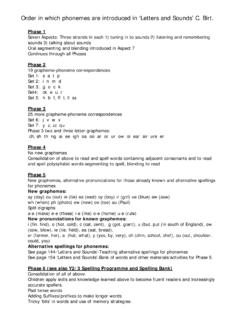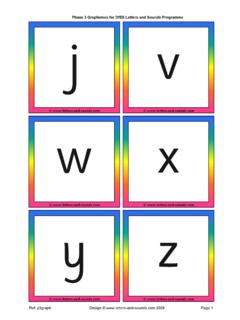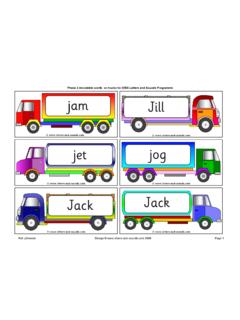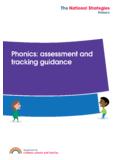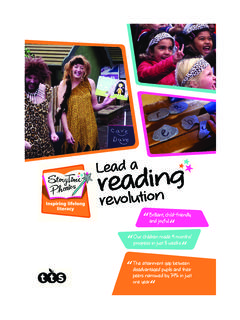Transcription of Hindi - Playaway
1 Hindireading bookletPI MSLE URSIMON & SCHUSTER S Graphic Design: Maia Kennedy and Recorded Program 2006 Simon & Schuster, Inc. Reading Booklet 2006 Simon & Schuster, is an imprint of Simon & Schuster Audio, a division of Simon & Schuster, Inc. Mfg. in rights should always check with their nation's State Department for current advisories on local conditions before traveling Instructor ..Ray BrownHindi-Speaking Instructor ..Vivek MathurFemale Hindi Speaker ..Dolly RajaMale Hindi Speaker ..Bharat Singhcourse WritersDr. Jilani Warsi Christopher J.
2 GaintyeditorsElizabeth Horber Beverly D. HeinlereVieWersAnoop Bhargava Dilnavaz BamboatexecutiVe ProducerBeverly D. HeinleProducer & directorSarah H. McInnisrecording engineersPeter S. Turpin Kelly SauxSimon & Schuster Studios, Concord, MAiiiTAbLE Of CONTENTSR eading LessonsIntroduction .. 1 Devanagari Alphabet .. 5 Lesson One .. 9 Lesson Two .. 10 Lesson Three .. 11 Lesson Four .. 12 Lesson Five .. 13 Lesson Six .. 14 Lesson Seven .. 15 Lesson Eight .. 16 Lesson Nine .. 17 Lesson Ten .. 18 Lesson Eleven .. 19 Lesson Twelve .. 20 Lesson Thirteen.
3 21 Lesson Fourteen .. 22 Lesson Fifteen .. 23 Lesson Sixteen .. 24 Lesson Seventeen .. 25 Lesson Eighteen .. 26 Lesson Nineteen .. 27 Lesson Twenty .. 28ivHINDII ntroductionHindi is one of 23 official languages of India, and is reported to be the second most commonly spoken language in the world. (Only Mandarin Chinese has a greater number of speakers.) Approximately 500 million people around the world speak a dialect of Hindi , and an even greater number have at least some familiarity with it. India s popular Bollywood films have served to expose viewers in many parts of the world to the sounds of Hindi .
4 However, included in those 500 million are speakers of the many regional dialects of the language, which are often quite different. Hindustani is the term used to describe this closely related series of languages or dialects, including Hindi and Urdu. In this course, we teach Standard Hindi as spoken in New Delhi. While elsewhere in India other dialects are more prevalent, the New Delhi dialect will be understood by most people you will meet. And while there are 23 official languages, only Hindi and English are official government languages of Hindi language actually shares some roots with English, as both are considered descendants of the Indo-European parent language spoken in Central Asia approximately seven thousand years 2 HINDII ntroduction (continued)ago.
5 However, while English has its linguistic roots in the West Germanic language family, Hindi is a descendant of the classical Sanskrit of Central Asia and belongs to the Indo-Iranian family. Today, most Indians are multi-lingual, speaking Hindi , English (one of the main dialects of English, called Indian English ), and one or more regional is a close relative of the Urdu language spoken in Pakistan, and speakers of the two languages can often understand one another, at least to some extent. Both languages are descendants of the collo-quial Hindustani spoken in northern India in the ninth and tenth centuries.
6 (The name Hindi is of Persian origin, and was first used by Persian-speaking Turks who established the Delhi Sultanate in the eleventh century ) That said, the marked cultural differ-ences between India and Pakistan have caused the Hindi and Urdu languages to develop along somewhat different lines, so that they are no longer entirely mutually comprehensible. Though extremely similar, the two are now considered separate languages. Urdu is written in a Persian-Arabic script, while Hindi is written in the Devanagari script. 3 HINDII ntroduction (continued)The written system of Hindi , known as Devanagari, dates back to approximately the 11th century There are also other languages, such as Sanskrit, Marathi, and Nepali, which use the Devanagari script.
7 A noticeable feature of Devanagari is the top horizontal line which is formed when letters are combined. Hindi is read from left to right and written with spaces between words. However, the letters which make up a word often combine and when the letters join together they sometimes change form. In Hindi there is a definite correspondence between spelling and pronun-ciation. There are a total of 11- 14 vowels and 33 - 36 consonants, depending on the chart used. There are no capital letters, but Hindi vowels have a different appearance when they appear independently or following another vowel than they do when they appear in a word following a consonant.
8 In a word following a consonant, they change to what is known as a maatraa form. As a maatraa, a vowel can be placed before, after, above, or below a consonant. Devanagari also includes several diacritical marks, the chandrabindu and bindu, which nasalize the Hindi is written using the Devanagari alphabet, you will need to learn to associate the sounds with what is probably a new system of symbols. A listing of the Devanagari alphabet can be found beginning on page 5. This is for your reference only; you will not need the list to learn to read Hindi , since all of the instruction is on the (continued)
9 For more information, call 1-800-831-5497 or visit us at Alphabet VowelsTransliteration Sound * Maatraa Letter None a as in abouta o a as in fatheraa oi as in siti o ee as in seemee o u as in putu o oo as in pooloo o a as in lateei o a as in glad ae o o as in goou o aw as in sawau Noneri as in grip This vowel occurs only in words that are borrowed from Sanskrit and is in HindiriDiacritical Markschandrabindu nasalizes vowels o bindu nasalizes vowels o * The circle represents a consonant and shows the relative position of the maatraa to the Alphabet
10 ConsonantsTransliteration Sound Letter within a word or at the end of a word like the k in skit; sometimes in the beginning of words the g as in goldk breathy-k as in look-herekh g as in gateg breathy-g as in dog-housegh ng as in swingn ch as in checkch breathy-ch as in catch-himChch j as in Junej breathy-j as in dodge-himjh This sound does not exist inEnglish; most like the n in unjust combination of t and d as in train /drainT breathy-t as in ant-hillTh d as in dateD This sound does not exist in English; most like an r followed bya quick dRa breathy-d with a very noticablebreath at the Sound Letter Devanagari Alphabet Consonants (continued) breathy-RaRha This sound does not exist inEnglish.

